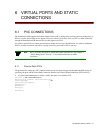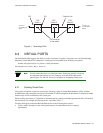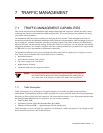
6-6 SmartSwitch 6500 User Guide
PVP Connections Virtual Ports and Static Connections
3. Use the add pvp command to create the pvp connection:
Smart6500 # add pvp
ConnType(PTP) :
< See note below
Port-1-Number() : 7a4
< Specify the first port
Port-1-VPI() : 1
< Specify its VPI
Port-2-Number() : 7b1
< Specify the second port
Port-2-VPI() : 1
< Specify its VPI
Port1-to-Port2TrafficDescriptorIndex() : 2
< Set the traffic descriptors
Port2-to-Port1TrafficDescriptorIndex() : 2
Smart6500 #
Note Point-to-multipoint PVPs are currently not supported on the SmartSwitch 6500.
4. Use the show pvp command to display the PVP connection:
Smart6500 # show pvp
PortNumber(ALL) :
CrossConnectId(ALL) :
CrossConnectSubId(ALL) :
=======================================================================
Conn Conn | Low | High | Admin
Id SubId | Port VPI Type| Port VPI Type | Status
=======================================================================
3 1 7A4 1 PTP 7B1 1 PTP UP
Total number of PVPs = 1
Smart6500 #
In the example above, we stopped ILMI and signaling on the ports used for the PVP. Stopping ILMI and signaling is
characteristic of a “true” PVP connection. However, if necessary, a PVP can be created between ports running ILMI
and signaling. In this case, the PVP coexists with the rest of the connections (if any) established across the connection.
6.2.1 Connecting PVPs
PVPs are physically connected to other devices in the following two ways:
•
Physically connecting the PVP port to another PVP switch
When connecting to another PVP switch, the VPI numbers assigned to the ports carrying the PVP on each switch
must match. For example if a PVP exits switch 1 on port 7a1 and enters switch 2 on port 3b4, the VPI number
assigned to port 7a1 on switch 1 and port 3b4 on switch 2 must be the same (see Figure 6-1).
•
Terminating the PVP port to a virtual port
PVPs can be terminated on virtual ports (see Section 6.3). To terminate a PVP on a virtual port, the virtual port
number must be the same as the VPI number for the PVP (see Figure 6-1). For example, to terminate a PVP with
VPI number of 3, physically connect it to a port that contains a virtual port with virtual port number equal to three
(7a1.3, 5b2.3, 6b4.3 and so on).


















